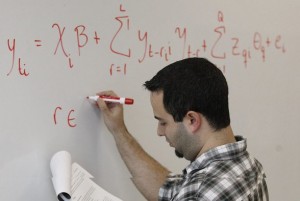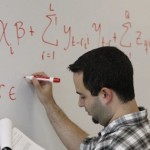Classroom Contemplations: The Worth of Value Added

CHARLES TRAINOR JR. / Miami Herald
Miami-Dade high school advanced calculus teacher Orlando Sarduy writes out the formula that will grade and help determine the pay of Florida teachers.
Editor’s note: Names of teachers and students have been changed.
The new term of art within the educational conversation about how we sort the good teachers from the bad is “value added.”
We stole the phrase from economics. But in the educational context, it brings to mind the great George Orwell quote: “The slovenliness of our language makes it easier for us to have foolish thoughts.”
We now throw this term around a lot. The mathematical formulas designed to identify the effect an individual teacher is having on an individual student are called “value-added” models. Administrators, researchers and policy-makers speak of the “value added” by a particular teacher — the difference in a student’s learning between excellent, good and poor teachers.
And, Orwell was right. It sure is making us foolish.
The whole notion of a teacher “adding value” harkens back to a practice that I thought disappeared: The assembly-line, factory model of teaching.
We used to share an idea that children pass through schools, (which, not coincidentally, look like factories and even share the same warning bells), various things are done to these children in sequence and they emerge as fully-formed, thinking adults.
Such thinking was eventually rejected when we realized that children are not cheeseburgers or Buicks.
They aren’t all they same; they aren’t products being turned out. Their education and development is the result of a much more complex system than an assembly line.
But this notion that each teacher adds a particular amount of value, quantifiable through simple standardized test scores, is a bygone simplistic view.
Education is an interaction — not just between an individual teacher and a student — but between a student and his or her class, his or her school and even his or her neighborhood. It’s an interaction difficult to reduce to a single statistic measured by a standardized exam.
I am not saying that we should throw up our hands and declare that we cannot measure teacher effectiveness. I am saying that we have to think carefully about what teacher effectiveness means before we start to measure it.
One of my favorite quotes about teaching (which has been misattributed so many times that I’m unable to determine the true origin) is “Teaching is not the filling of a pail, but the lighting of a fire.”
We as teachers do not fill the cup of knowledge of our students. At our best, we show them how to learn and give them tools to do so.
We do not add value the way you add chocolate chips to a cookie, or special sauce to a cheeseburger coming down the line.
So, how do teachers add value? We’re going to let teachers tell you themselves. In future posts, you’ll be hearing teachers explain the effect they’ve had on the lives of some of their students.
Through these stories, we will try to add some value to the term “value added” itself so that, to do George Orwell proud, we can prevent our own foolish thinking about schools.
Jeremy Glazer is a Miami-Dade teacher writing about classroom issues for StateImpact Florida. Want to sound off on something Glazer has written? Want to suggest a topic for him? Send us an email at Florida@stateimpact.org and put “Classroom Contemplations” in the subject line.

